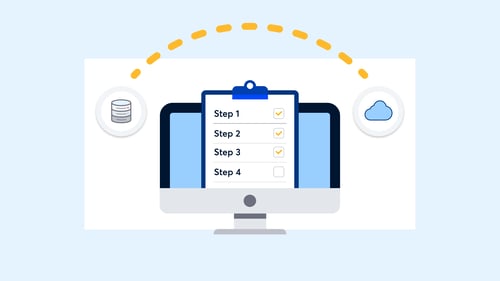Creating a solid data migration strategy: Key steps for a successful transition [+ Template]

Data migration is a critical process that organizations must undertake for various reasons, such as reducing license costs, adopting new technologies, or consolidating multiple systems during mergers and acquisitions. The growth of data silos, increasing regulation and compliance requirements, and the need to extract more value from existing data are all key macro drivers that accelerate the demand for data migration. However, outdated migration processes can cause significant losses of time, productivity, and finances for organizations. A survey by Matillion and Vanson Bourne revealed that businesses may face up to $43.5 million in annual costs due to outdated migration and maintenance processes.
To minimize the costs and risks associated with migrating data, it's crucial to have a well-crafted plan that outlines the goals and approach for moving data from one environment to another. In this blog post, we'll explore the key steps involved in creating a robust data migration strategy, including assessing data quality, defining project scope, selecting a migration approach, and testing and validation. We'll also provide a downloadable data migration plan template at the end of this post, which outlines specific steps and tasks necessary for executing the migration strategy successfully.
Let's dive in and get started.
What is data migration?
In simple terms, data migration refers to the process of transferring data from one system, format, or location to another. This process can vary widely depending on the type of data being migrated, the source and target systems, the volume of data, and the desired outcome.
For example, an IT department may be tasked with moving data from a legacy system to a new system while maintaining data integrity and minimizing disruption to end-users. On the other hand, a business undergoing a merger or acquisition might need to integrate data from various sources into a single database or system.
It's worth noting that certain industries may have regulations or requirements for data migration, including rules for data retention. For instance, healthcare organizations must comply with HIPAA regulations, while financial institutions must adhere to data security standards. In such cases, the definition of data migration may also include specific steps, procedures, or retention requirements necessary to ensure compliance.
At its core, data migration ensures that a company's data is accessible, accurate, and secure. Whether upgrading to a new system or consolidating data sources to reduce costs, data migration can streamline business processes, improve data quality, and ultimately drive better business outcomes.
![Data migration is not just about moving data from one place to another. [For us at Onna], it's about taking the time to select, prepare, extract, and transform legacy data into something truly valuable. By bringing all your data together in one place and standardizing it, you can break down silos, save costs, and make your data more accessible and reliable than ever before. - Jose Lazares, Chief Product Officer, Onna](https://onna.com/hs-fs/hubfs/2023%20website/blog/blog-image-data-migration-strategy.png?width=3840&height=2166&name=blog-image-data-migration-strategy.png)
Why every business needs a data migration strategy
Every business, regardless of the reason for migration, must include a data migration strategy in their overall data management plan. The strategy should comprehensively plan for the secure transfer of data from one system to another while minimizing the risk of data loss or corruption during the migration process. This is necessary because there is an increasing demand for data migration due to the expansion of data silos, the need to comply with regulations, and the desire to extract more value from current data or reduce costs. If a business does not have a data migration project on the horizon now, it is only a matter of time before they do. Failing to migrate data properly can result in compliance issues, data loss, and additional costs.
To ensure a seamless migration, a well-designed data migration strategy should consider different methods and techniques for transferring data. It should also factor in costs such as storage capacity, distance, migration time, and the number of data sources involved. By implementing a data migration strategy, organizations can accurately and securely transfer data to the new system while avoiding subpar experiences that create more problems than they solve.
Ready, set, migrate: Key steps to creating a solid data migration strategy
To create a solid data migration strategy, careful planning and consideration of various factors are necessary. While there is no one-size-fits-all approach, the following steps should be kept in mind:
- Define the scope of the data migration project. Analyze the existing data to determine what can be migrated with minimal disruption, taking into account the data volume and activity level.
- Identify and assess data sources. Pinpoint the data sources, determine the data type and format that needs to be migrated, identify any data dependencies or limitations, and research specific eDiscovery or compliance requirements.
- Develop a data migration plan and timeline. Define migration objectives and outcomes, establish migration and testing workflows, set a reasonable timeline, create milestones for the project, and define the migration process.
- Build a cross-functional project team. Assemble a team with the right mix of skills and experience to handle the tasks ahead. Define roles and responsibilities for the project, and consider having an experienced professional or expert on board to guide the team through the project's challenges and confidently handle any issues that may arise.
- Review and update policies and procedures. Determine the best organizational structure for your data before beginning the migration. Consider reorganizing your old data to match the new structure and setting up the data differently to align with current workflows.
- Evaluate and select the appropriate migration tools. Automation has made data migration more efficient, and tools are available to gather, prepare, extract, and transfer data. Identify specific migration tool needs, research and evaluate various tools, and select the best solution.
- Test and validate the migration plan. Develop test cases, test the process on a small scale, and validate the data for integrity and consistency.
- Communicate the migration plan to stakeholders. Clearly define and communicate the migration plan to stakeholders to set expectations and keep them informed of milestones, changes, and risks.
By carefully following these steps, assessing your specific needs and goals, and planning ahead to overcome the most common data migration challenges, you can successfully achieve your desired results.
The importance of data mapping and monitoring
Data mapping is a method used by organizations to create a comprehensive inventory of the data types and formats they generate, use, and store, including their location, responsible parties, and archiving or deletion schedules. This approach enables effective information governance and litigation readiness.
Achieving effective information governance and litigation readiness starts with understanding the data that exists, its location, and the responsible parties managing it. To maintain data integrity, a functional data map should be regularly monitored and updated. By doing so, organizations can respond effectively to eDiscovery or regulatory compliance document requests. Continually updating data maps ensures that organizations stay prepared to respond to any requests or challenges that may arise.
Download the data migration plan template and get started today
Creating a data migration strategy is a critical aspect of any data management plan, and it requires careful planning and execution. By considering essential factors such as data scope, target systems, and migration methods, you can ensure the success of your migration projects. To make the planning process more accessible, we have created a comprehensive data migration plan template that you can download and customize to fit your specific needs.
Download the template today and take the first step toward a successful migration.
 eDiscovery
eDiscovery Collections
Collections Processing
Processing Early Case Assessment
Early Case Assessment Information Governance
Information Governance Data Migration
Data Migration Data Archiving
Data Archiving Platform Services
Platform Services Connectors
Connectors Platform API
Platform API Pricing Plans
Pricing Plans Professional Services
Professional Services Technical Support
Technical Support Partnerships
Partnerships About us
About us Careers
Careers Newsroom
Newsroom Reveal
Reveal Logikcull by Reveal
Logikcull by Reveal Events
Events Webinars
Webinars OnnAcademy
OnnAcademy Blog
Blog Content Library
Content Library Trust Center
Trust Center Developer Hub
Developer Hub